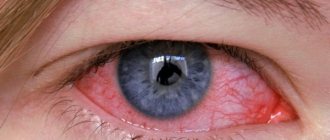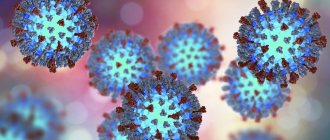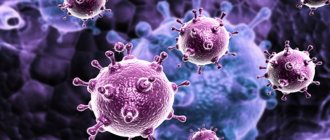Mononucleosis in children most often appears between the ages of two and fifteen years. This is an infectious disease that resembles the flu or sore throat in its symptoms, but it also affects internal organs. It is transmitted by airborne droplets, and the pathology persists for life, and with a decrease in immunity, it is capable of relapse. In severe cases, when the infection cannot be detected, it can be fatal.
Pathogen
Infectious mononucleosis in children is caused by the Epstein-Barr virus (herpes type 4), which belongs to the genus Limphocryptovirus, subfamily Gammaherpesvirinae, family Herpesviridae. The action of the infectious agent is aimed at damaging the body's lymphatic system. The virus has the following features:
- captures lymphocytes - cells of the immune system that resist infection;
- penetrates their DNA, changes genetic information, disrupts functions;
- does not cause the death of lymphocytes, but stimulates cell growth, unlike other herpes viruses.
The infectious agent quickly dies in the external environment from drying out, the action of disinfectants (antimicrobial drugs), and high temperatures. The Epstein-Barr virus is dangerous for humans because it has the following properties:
- remains in the body;
- within 18 months after infection, it is released into the external environment from the oropharynx;
- disrupts liver function;
- damages the pharyngeal and palatine tonsils;
- increases the risk of developing cancer pathologies.
How is it transmitted?
Viral mononucleosis in children is transmitted in several ways. The source of infection is a patient or a virus carrier (a person who has been ill and recovered). Children and teenagers get sick more often. Infection often occurs where sick and healthy people come into close contact - in schools, kindergartens, and dormitories. There are several ways of infection:
- Intrauterine. The fetus becomes infected through the general bloodstream from a sick mother during pregnancy.
- Airborne. Physiological fluids - mucus, saliva get to a healthy child from a sick child when coughing or sneezing.
Most people who have had an infection in childhood or adolescence develop antibodies to the virus. In this case, a person remains a carrier of the pathogen for the rest of his life and can transmit it during a blood transfusion, during an organ or bone marrow transplant operation . Doctors identify a contact and household method of infectious infection. The virus is transmitted through saliva through kissing. The causative agent of mononucleosis comes from a sick child as a result of using:
- shared toys in kindergarten;
- someone else's bed linen, clothes;
- shared dishes, towels;
- someone else's nipples.
Reasons for development
Pathology is transmitted from one person to another during the acute period. At first, the patient does not experience any discomfort or characteristic symptoms. Infection occurs through close contact. The virus is transmitted in several ways:
- through a kiss;
- by blood transfusion;
- while traveling on public transport;
- when using other people's personal hygiene products.
Mononucleosis is diagnosed in adults and children with weak immunity. The risk group includes people who have suffered severe stress, have serious mental illnesses, and subject the body to great physical stress. During primary infection, the virus is released into the environment for 2 years.
The duration of the incubation period is 7-20 days. This form of the disease often occurs in childhood or adolescence. Girls get sick at the age of 15, and boys at 18. The pathology rarely occurs in people over 45 years of age, since the body produces special antibodies that can resist the spread of the virus.
Forms
Doctors distinguish several types of mononucleosis. They differ in the course of the disease and symptoms. The following forms of infection cannot be ruled out:
- Typical – characterized by fever, sore throat, enlarged spleen and liver. Blood tests indicate the presence of mononuclear cells (a type of white blood cell) and heterophilic antibodies.
- Atypical form. Its symptoms are smoothed out or have a strong severity. The child may develop a high temperature, and damage to the nervous system, heart, kidneys, and lungs may begin. The infection has a tendency to develop complications.
Often the disease occurs in an acute form with pronounced symptoms. In the absence of treatment and the presence of a large number of viruses in the body, the infection becomes chronic. Depending on the symptoms, the degree of enlargement of the lymph nodes, spleen, liver, the amount of mononuclear cells in the blood, the stage of the disease is divided into severe, moderate and mild. According to the nature of the course of mononucleosis in children, the following forms are distinguished:
- smooth;
- uncomplicated;
- complicated;
- protracted
Symptoms of the disease
As mononucleosis progresses, patients experience severe malaise and a sharp deterioration in their general condition . The following characteristic signs of pathology can be identified:
- fever;
- tonsillitis;
- enlarged lymph nodes and tonsils;
- severe soreness in the throat.
The liver and spleen increase in size. Patients' blood composition changes. After the infection penetrates, during the first days, patients experience mild malaise, weakness, headaches, and muscle spasms. Due to the development of severe pain in the joints, a person may experience stiffness of movement.
Body temperature increases to 39 °C. It rises sharply in the evening and decreases after waking up. Temperature changes can remain undulating for 24 hours. The duration of this stage is no more than three weeks.
Symptoms of tonsillitis progression occur on the second day or 7-10 days after infection. The disease occurs in two forms:
- catarrhal (patients experience slight swelling of the tonsils, lacunar inflammation occurs in severe form);
- ulcerative-necrotic (the patient develops a fibrinous film, which has the same structure as in diphtheria).
These symptoms prevent the patient from leading a normal life. Pathological changes occur in different systems and internal organs:
- Development of nasopharyngitis. Patients have difficulty breathing, heavy discharge appears on the back wall of the throat, and complaints of nasal congestion occur. Doctors note a spear-shaped plaque on the mucous membrane. The discharge may have a loose cheesy layer on the tonsils of a white-yellow hue.
- The disease is accompanied by an inflammatory process, which is localized in the angular jaw and cervical lymph nodes. They swell and increase in size by 3 cm. In rare cases, the axillary, cubital, inguinal and lymph nodes are affected.
- The infection affects the lymph flow of the intestinal mesentery. As a result, the inflammatory process progresses and a pathological rash occurs. Patients are faced with papules and age spots. Purulent neoplasms go away on their own within 4-5 days. There are no relapses.
Mononucleosis does not have uniform systematized clinical forms. Depending on the severity and form of the pathology, symptoms are typical and atypical. During a histological examination, the doctor can confirm the involvement of several important organs in the inflammatory process.
In patients, the interstitial tissue in the lungs becomes inflamed and the number of cellular components of the brain decreases. As a result of the pathology, hypoplasia develops and the choroid of the eyeball is affected. Characteristic symptoms of mononucleosis are poor sleep, nausea, diarrhea, and in rare cases, vomiting. As mononucleosis progresses, intra-abdominal tumors and lymphatic lymphomas develop.
Symptoms in children
If the baby has a strong immune system, the infectious agent, once in the body, can live in it asymptomatically for a long time. The incubation period lasts 21 days, but with weakened protection, the infection develops after 5 days. The symptoms of mononucleosis are similar to other diseases; pediatricians must differentiate them from the following pathologies:
- lymphogranulomatosis;
- viral hepatitis;
- acute respiratory infections;
- rubella;
- acute leukemia;
- diphtheria;
- angina;
- HIV.
The very first symptom of the development of an infectious disease is enlarged lymph nodes. The cervical, occipital, and submandibular peripheral organs are most affected; inflammation is accompanied by severe pain. As the infection develops, the inguinal, abdominal, and axillary lymph nodes enlarge. Then inflammation of the tonsils and swelling of the tissues in the nose appear. The following signs of mononucleosis in children are observed:
- sore throat when swallowing;
- white plaque on the tonsils;
- bad breath;
- difficulty in nasal breathing;
- night snoring;
- runny nose;
- cough.
When infected with the Epstein-Barr virus, the body becomes intoxicated with waste products. At the same time, the temperature rises to 39 degrees, fever, chills, aches in the bones and muscles are observed. Symptoms of mononucleosis include:
- pink rash all over the body, with no itching, which goes away on its own;
- enlarged spleen, liver;
- darkening of urine;
- headache;
- high fatigue;
- refusal to eat;
- weakness;
- lethargy.
Infection increases sensitivity to the development of respiratory pathologies. There is a disturbance in the functioning of the heart - murmurs, rapid heartbeat. The disease is accompanied by the following symptoms:
- development of sore throat, bronchitis;
- changes in blood counts;
- damage to the lips by the herpes simplex virus;
- swelling of the eyelids, face;
- dizziness;
- migraine;
- insomnia;
- fatigue syndrome.
Article on the topic: Ointment for barley on the eye - a list of the best drugs with a description of the composition, instructions for use and prices
Chronic mononucleosis
The danger is posed by late diagnosis of infection and lack of timely treatment. The disease becomes chronic. The temperature during mononucleosis in children in this case remains normal, the following symptoms are present:
- constant enlargement of lymph nodes;
- fast fatiguability;
- drowsiness;
- decreased activity;
- bowel dysfunction - constipation, diarrhea;
- stomach ache;
- nausea;
- weakness;
- vomit.
Symptoms of the chronic form of infection are often similar to the acute form, but are less severe. Enlargement of the spleen and liver occurs rarely. The disease is dangerous due to the development of the following complications in a child:
- hemophagocytic syndrome - destruction of the body's own blood cells;
- damage to nerve centers, brain;
- changes in heart function;
- blood clotting problems;
- violation of facial expressions;
- development of migraine;
- psychoses;
- anemia.
Spicy
More often, the infection occurs in an acute form, which lasts up to two months. Lymphadenopathy develops - damage to the lymph nodes, accompanied by an increase in size and pain. Swelling of the mucous membranes of the oral cavity provokes breathing problems and throat hyperemia. The child complains of the appearance of:
- general weakness;
- sore throat, especially when swallowing;
- nasal congestion;
- runny nose;
- severe chills;
- lack of appetite.
The acute form of mononucleosis is characterized by fever, nausea, aches in the muscles, joints, and fever. When children develop an infection, they may:
- hepatomegaly – enlarged liver;
- small rash on the chest, back, face, neck;
- white plaque on the tonsils, palate, tongue, back of the throat;
- splenomegaly - an increase in the size of the spleen;
- photophobia;
- swelling of the eyelids
Cytomegalovirus infection
Symptoms
- A sore throat
- Enlarged lymph nodes in the neck
Cytomegalovirus infection is a disease caused by cytomegalovirus, a virus from the herpesvirus subfamily, which also includes herpes simplex viruses 1 and 2, varicella zoster virus, Epstein-Barr virus and human herpesviruses types 6,7 and 8.
The prevalence of cytomegalovirus infection is extremely high. Once the virus has penetrated the body, it does not leave it - most often it exists in a latent form and appears only when immunity decreases in both children and adults.
Victims of cytomegalovirus infection often include people living with HIV, as well as people who have had internal organ or bone marrow transplants and are taking drugs that suppress the immune response.
However, with primary infection, an acute infectious disease can occur. Infection often occurs after birth and in early childhood, and is especially common in countries with low social and economic development, where the prevalence of cytomegalovirus infection among young people is much higher than in developed countries.
| The most dangerous development of cytomegalovirus infection during pregnancy |
The most dangerous is the intrauterine form of cytomegalovirus infection, which is typical for children whose mothers suffered a primary cytomegalovirus infection during pregnancy. Congenital cytomegaly often leads to mental retardation and numerous other adverse effects.
How does cytomegalovirus infection occur?
Cytomegalovirus infection is not very contagious. Its transmission requires prolonged close communication or repeated contacts.
- Airborne droplets: when talking, coughing, sneezing, kissing, etc.
- Sexual contact: During sexual contact, the risk of transmitting the virus is very high, since the virus is excreted in semen, vaginal and cervical mucus.
- During transfusion of blood and its components containing leukocytes.
- From mother to fetus - most often with a primary cytomegalovirus infection or reactivation of a latent infection during pregnancy.
How does cytomegalovirus work?
| For many people, the virus remains dormant throughout their lives. |
The virus enters the blood of a healthy person and causes a pronounced immune response, which consists of the formation of antibodies - specific protective proteins - immunoglobulins M (Anti - CMV - IgM).
CD 4 and CD 8 lymphocytes have potent activity against cytomegaloviruses. Therefore, when the cellular immune response is suppressed, for example, when the formation of CD 4 lymphocytes is impaired in AIDS, cytomegalovirus infection actively develops and leads to the reactivation of a previously latent infection.
Immunoglobulins M against cytomegalovirus are formed approximately 4-7 weeks after infection and remain in the blood for 16-20 weeks. Detection of them in the blood during these periods may be evidence of a primary cytomegalovirus infection. Then immunoglobulins M are replaced by immunoglobulins G (Anti - CMV - IgG), which are present in the blood to varying degrees throughout subsequent life.
In most cases, with normal immunity, cytomegalovirus infection is asymptomatic, although it remains in the body for a long time as a latent infection. Where exactly the virus is stored is unknown; it is assumed to be present in many organs and tissues.
Cells affected by cytomegalovirus have a characteristic appearance - they increase in size (which determined the name of the virus), and upon microscopic examination they look like an “owl’s eye”.
Even asymptomatic carriers are capable of transmitting the virus to uninfected individuals. An exception is the transmission of the virus from mother to fetus, which occurs mainly only during an active infectious process, but only in 5% of cases leads to congenital cytomegaly; in other newborns, cytomegalovirus infection is also asymptomatic.
Mononucleosis-like syndrome
Mononucleosis-like syndrome is the most common form of cytomegalovirus infection in persons with normal immunity who have emerged from the neonatal period. Based on its clinical manifestations, it cannot be distinguished from infectious mononucleosis, which is caused by another herpesvirus, the Epstein-Barr virus.
The incubation period is 20-60 days. The syndrome occurs in the form of a flu-like illness:
- Prolonged high fever, sometimes with chills;
- severe fatigue, malaise;
- pain in muscles, joints, headache;
- sore throat;
- enlarged lymph nodes;
- A skin rash similar to that of rubella is rare and is more common when treated with ampicillin.
Sometimes primary cytomegalovirus infection is accompanied by signs of hepatitis - jaundice is rare, but an increase in liver enzymes in the blood often occurs.
Rarely (0-6% of cases) mononucleosis-like syndrome is complicated by pneumonia. However, in immunologically healthy people it is asymptomatic and is detected only by chest x-ray.
The disease lasts for 9-60 days. Most patients recover completely, although residual effects in the form of weakness and malaise, sometimes enlarged lymph nodes, persist for several months. Recurrent infections, accompanied by fever, malaise, hot flashes, and sweating, are rare.
Congenital cytomegalovirus infection
Intrauterine infection of the fetus is not always the cause of congenital cytomegaly; in most cases it is asymptomatic and only in 5% of newborns leads to the development of the disease. Congenital cytomegaly occurs in newborns whose mothers have suffered a primary cytomegalovirus infection.
Manifestations of congenital cytomegaly vary widely:
- Petechiae - skin rashes, which are small hemorrhages, occur in 60-80% of cases;
- jaundice;
- intrauterine growth retardation, prematurity occurs in 30-50% of cases;
- chorioretinitis - inflammation of the retina of the eye, which often leads to decreased vision and loss of vision;
The mortality rate for congenital cytomegalovirus infection is 20-30%. Most surviving children are mentally retarded or hard of hearing.
Acquired cytomegalovirus infection in newborns
| Cytomegalovirus infection in newborns can occur in the form of skin rashes |
When infected with cytomegalovirus during childbirth (through the birth canal) or after birth (through breastfeeding or normal contact), in most cases the infection remains asymptomatic.
However, in some, especially in premature and low birth weight infants, cytomegalovirus infection is manifested by the development of prolonged pneumonia, which is often accompanied by the addition of a bacterial infection.
In addition, there may be a slowdown in physical development, rash, enlarged lymph nodes, and hepatitis.
Persons with weakened immune systems
People with weakened immune systems include:
- With various variants of congenital immunodeficiency;
- with acquired immunodeficiency syndrome (AIDS);
- who have undergone transplantation of internal organs: kidney, heart, liver, lungs, and bone marrow.
The severity of clinical manifestations depends on the degree of immune suppression, but chronic use of immunosuppressive drugs leads to more severe manifestations.
Cytomegalovirus infection after transplantation
- Cytomegalovirus especially often affects the transplanted organs themselves, causing hepatitis of the transplanted liver, pneumonia of the transplanted lungs, etc.
- After a bone marrow transplant, 15-20% of patients develop cytomegalovirus pneumonia, which kills 84-88% of patients.
- The greatest risk of developing cytomegalovirus infection is if the donor is infected and the recipient is not.
Cytomegalovirus infection in HIV-infected patients
Almost all AIDS patients suffer from cytomegalovirus infection; the following symptoms are typical:
- The onset of infection is usually subacute: fever, malaise, night sweats, muscle and joint pain develop.
- Pneumonia – the initial signs of the disease include coughing and increased breathing.
- Ulcers of the esophagus, stomach, intestines, which can lead to bleeding and rupture of the wall.
- Hepatitis.
- Encephalitis is an inflammation of the brain. May manifest as AIDS dementia syndrome or damage to the cranial nerves, drowsiness, disorientation, nystagmus (rhythmic movements of the eyeballs).
- Ritinitis, an inflammation of the retina, is a common cause of vision loss in patients with reduced immunity.
- Multiple organ damage is damage by the virus to almost all organs, leading to their dysfunction. It is often the cause of death from cytomegalovirus infection.
Prevention of cytomegalovirus infection
It is advisable to prevent cytomegalovirus infection in people at risk. These include people living with HIV, especially those with AIDS; persons who have undergone internal organ transplantation; persons suffering from immunodeficiency due to other reasons.
Compliance with the rules of personal hygiene, even the most careful, does not allow one to avoid infection with cytomegaloviruses, since they are ubiquitous and are transmitted by airborne droplets. Therefore, prevention in patients at risk is carried out with antiviral drugs: Ganciclovir, Foscarnet, Acyclovir.
To reduce the likelihood of cytomegalovirus infection among recipients of internal organs and bone marrow, careful selection of donors is recommended, taking into account their infection with cytomegalovirus infection.
Diagnosis of cytomegalovirus infection
Laboratory diagnosis of cytomegalovirus infection is based on serological examinations - determination of cytomegalovirus-specific antibodies in the blood.
- Immunoglobulins M - Anti - CMV - IgM;
They are markers of acute infection: primary cytomegalovirus infection or reactivation of chronic infection. If high titers of antibodies are detected in pregnant women, there is a risk of infection of the fetus. They rise only 4-7 weeks after infection and remain elevated for 16-20 weeks.
- Immunoglobulins G - Anti - CMV - IgG;
The titer of this type of immunoglobulin increases already during the period of decreased activity of the infectious process. The presence of Anti-CMV-IgG in the blood only indicates the presence of cytomegalovirus in the body, but does not in any way reflect its activity.
- Polymerase chain reaction;
PCR is based on determining the DNA of the virus in the blood or in mucosal cells (in scrapings from the urethral, cervical canals, as well as in saliva, sputum, etc.). It is recommended to perform a quantitative PCR reaction, which allows one to judge the degree of reproduction of the virus, and therefore the activity of the inflammatory process.
Treatment of cytomegalovirus infection
Mononucleosis-like syndrome with an uncomplicated course does not require special treatment. Traditional treatment, as for a common cold, is sufficient. The main thing is not to forget to drink plenty of fluids.
The drug of choice for the treatment of cytomegalovirus infection in patients at risk is Ganciclovir. Intravenous forms of the drug are used for treatment. Tablets are only effective for prevention.
Side effects of Ganciclovir:
- Inhibition of blood cell formation (neutropenia, anemia, thrombocytopenia). Develops in 40% of cases.
- Diarrhea (44%), vomiting, loss of appetite.
- An increase in temperature (48% of patients) is accompanied by chills and sweating.
- Skin itching.
Warnings:
- Ganciclovir is not used in people without immune disorders.
- The use of Ganciclovir in pregnant women and children is possible only in life-threatening situations.
- Dosages need to be adjusted in people with impaired renal function.
Foscarnet is also used for treatment, which is considered more effective in patients with HIV infection.
Side effects:
- Electrolyte disturbances: decrease in blood potassium and magnesium.
- Ulcers of the genital organs.
- Urinary disorders (painful urination).
- Nausea.
- Kidney damage: the drug is nephrotoxic, therefore, in case of renal failure, careful use and dose adjustment of the drug is necessary.
Blood analysis
Laboratory tests play an important role in the differential diagnosis of infectious mononucleosis. Based on their results, pediatricians prescribe treatment. Blood tests are performed:
- General – determines ESR (erythrocyte sedimentation rate), the content of monocytes, leukocytes, lymphocytes. When sick, their number increases 1.5 times. Mononuclear cells appear in the blood only a few days after infection. The more there are, the more severe the disease.
- Biochemical - reveals the content of urea, protein, glucose, characterizing the condition of the kidneys and liver.
The presence of a large number of mononuclear cells in the child’s blood confirms the infection. Considering that this situation is possible in other pathologies, for example, in the case of HIV, doctors prescribe additional studies. Executed:
- ELISA – enzyme-linked immunosorbent assay for antibodies to the Epstein-Barr virus;
- PCR - polymerase chain reaction - a highly accurate, fast diagnostic method using the DNA of the infectious agent;
- Ultrasound of the liver and spleen for changes.
Diagnostic measures
The infectious form of mononucleosis is a common disease. The mild stage is subject to complex diagnostics. The main feature of the virus is damage to the lymphoid tissue that is found inside the spleen, lymph nodes, and tonsils. These organs suffer more often than others.
When a patient consults a doctor, he conducts an initial examination and establishes the main symptoms of the disease. The specialist notices a connection between the symptoms and mononucleosis, so he prescribes a laboratory test for the patient. The most informative is a blood test or monospot test. It helps to exclude the development of other diseases that cause similar symptoms.
An accurate diagnosis can only be made by obtaining the results of clinical and laboratory tests. The blood formula determines an increase in the number of lymphocytes, as well as atypical mononuclear cells. Thanks to serological tests, heterophilic antibodies to red blood cells can be diagnosed. in the salivary gland in the following situations:
- when the incubation period is over;
- during the development of infection;
- 5-6 months after the patient’s complete recovery.
The latent form of the Epstein-Barr virus can retain its properties in B lymphocytes for a long time. The highest concentration of viruses is in the mucous membrane of the oropharynx. They are isolated in 15% of patients who have had an infectious form of mononucleosis.
Modern laboratories are equipped with innovative equipment, so specialists use disposable sterile instruments when collecting biological material. Thanks to such preparation, you can get a more accurate result. The disease is considered detected if there is an infection in the body.
Doctors can determine the form of pathology and the period of activation of the bacterial process. A negative result indicates the absence of infection in the initial stages of the disease. To monitor the progress of the infection, patients should have their blood tested every 3 to 4 days, regardless of symptoms. Infectious mononucleosis in adults should be treated by a qualified specialist who will help prevent serious complications.
Treatment
When mononucleosis is diagnosed, the child is prescribed treatment at home with bed rest. If high temperature, fever, and signs of intoxication are observed during infection, hospitalization is performed. Indications for it are:
- damage to the respiratory tract, causing asphyxia (suffocation);
- disruption of internal organs;
- development of complications;
- repeated vomiting.
Uncomplicated mononucleosis in a child does not require special treatment. Pediatricians only recommend drinking plenty of fluids. In the acute stage of infection it is necessary:
- humidify the air in the room where the child is;
- avoid hypothermia;
- provide warm drinks;
- regularly carry out wet cleaning;
- use medications for treatment.
The treatment regimen for the disease is aimed at relieving the symptoms of the pathology and strengthening the immune system . Treatment of infectious mononucleosis in children solves several problems:
- reduction of hyperthermia (overheating of the body at high temperatures);
- reducing inflammation in the nasopharynx with antiseptic agents;
- activation of the immune system using immunomodulators, immunostimulants;
- increasing the body's resistance with the help of vitamin complexes;
- restoration of the functioning of the spleen and liver with choleretic agents and hepatoprotectors.
When treating an infection, much attention is paid to reducing allergic reactions to pathogens and toxins. The treatment regimen includes the use of:
- antibiotics in case of secondary infection;
- glucocorticosteroids for complicated hypertoxic disease, risk of asphyxia;
- probiotics to restore intestinal microflora after antibiotic therapy;
- artificial lung ventilation;
- surgical intervention: splenectomy (removal of the spleen in case of rupture), tracheotomy (opening of the trachea) in case of laryngeal edema.
Drug treatment
The use of medications is aimed at weakening and eliminating the symptoms of an infectious lesion. Doctors use several groups of medications to combat mononucleosis in children. For treatment the following is prescribed:
- Antipyretic drugs – Ibuprofen, Paracetamol. Aspirin is not recommended due to the risk of acute liver failure.
- Antiseptic Furacilin for gargling an inflamed throat.
- Antihistamines - Claritin, Zyrtec to eliminate allergic reactions, bronchospasm, symptoms of intoxication.
Antibiotics for mononucleosis in children are used only when a secondary bacterial infection develops. The drugs Clatrimycin, Azithromycin, Metronidazole are used with the simultaneous administration of probiotics Acipol, Linex to prevent disturbances of the intestinal microflora. The following medications are used to treat infectious diseases:
- hepatoprotectors – Essentiale, Galstena;
- choleretic – Allohol, Karsil;
- immunomodulators – Viferon, Imudon;
- glucocorticosteroids - Prednisolone - if there is a threat of asphyxia in case of laryngeal edema.
To treat the infection, homeopathic Galsten drops are used. The drug contains plant components: greater celandine, dandelion, milk thistle. Characteristics of the drug:
- action – hepatoprotective, choleretic, anti-inflammatory, antispasmodic;
- indications – liver pathologies in acute, chronic form;
- dosage – 5 drops, 3 times a day;
- contraindications – sensitivity to components;
- side effects - increased salivation.
Viferon is used in the form of rectal suppositories. The drug has an active substance - human interferon. Characteristics of the medicine:
- indications – infectious viral diseases complicated by the bacterial activity of microorganisms;
- dosage - set by the pediatrician depending on the severity of the pathology;
- contraindications – hypersensitivity to components;
- side effects - rarely skin rashes, itching.
Article on the topic: Ointment for bruises and sprains for athletes - a review of the best drugs with instructions and price
Diet
To quickly restore health during mononucleosis, it is important to organize nutrition in such a way as to strengthen the immune system, eliminate unpleasant symptoms, and speed up recovery. There are dietary rules for treating infection:
- daily calorie content of food is 1.5 times higher than normal - the body spends energy fighting the disease;
- The presence of animal and plant proteins is mandatory - the basis for cells that provide immunity.
Since the disease is accompanied by a sore throat and problems with swallowing, doctors recommend preparing liquid soups, viscous porridges, and purees for mononucleosis in children. Required for dietary nutrition are:
- obtaining vitamins, microelements, antioxidants from fresh vegetables, berries, fruits;
- eating whole grains to provide energy to the body.
During an infection, it is important to maintain a drinking regime - drink large amounts of water, fruit drinks, compotes, and rosehip decoction to remove toxins. The child’s diet requires the presence of:
- rice, wheat, oatmeal, buckwheat porridge;
- dried rye bread;
- low-fat dairy products - cottage cheese, sour cream, hard cheese;
- vegetable oil, butter;
- poultry, rabbit, veal;
- fish - cod, hake, pike perch, pike;
- durum pasta;
- greens - lettuce, parsley, dill;
- vegetables and fruits rich in fiber;
- berries;
- eggs - one per day;
- jam;
- honey
In case of mononucleosis, limit the consumption of fatty foods, smoked foods, and pickles, so as not to overload the liver. Sweets, sour and spicy foods are prohibited. Exclude from the diet:
- fatty meat - duck, lamb, beef, pork;
- confectionery products;
- sparkling water;
- concentrated meat broths;
- dairy products with a high percentage of fat;
- hot spices;
- fatty fish;
- fast food;
- canned food;
- chocolate;
- mayonnaise;
- ketchup;
- mushrooms;
- legumes;
- garlic.
Folk remedies
Recipes using herbal ingredients are part of the treatment regimen for mononucleosis, but do not replace it. The use of any folk remedies must be agreed with a doctor to exclude complications and allergic reactions in children. The main goal of treatment is to eliminate the symptoms of the disease. To maintain immunity, it is recommended to drink healing teas with honey three times a day. To prepare them, add dry herbs (in spoons) to half a liter of boiling water:
- infusion of birch, currants, lingonberries - one at a time, aged for 30 minutes;
- echinacea decoction – 3;
- lemon balm tea – 2.
Traditional healers recommend taking decoctions and infusions internally when sick. The course of herbal medicine lasts up to three weeks, drinking 2-3 glasses a day. Products based on medicinal plants help:
- eliminate fever - tea made from mint, chamomile, raspberry leaves with honey, lemon juice;
- counteract the symptoms of intoxication of the body - headache, body aches, nausea - linden blossom decoction, lingonberry juice;
- to alleviate the condition of illness - tea from the collection of oregano, motherwort, mint, rose hips.
To reduce inflammation of the lymph nodes, it is useful to make a compress with an infusion of medicinal plants. A napkin soaked in the composition is applied every other day for 20 minutes to the area of the nodes. To prepare the infusion, pour 5 tablespoons of the mixture into a liter of boiling water and leave for half an hour. The collection includes equal parts:
- currant, willow, birch leaves;
- chamomile flowers, calendula;
- pine buds.
How to treat mononucleosis with medication?
During treatment of mononucleosis, it is necessary to observe bed rest until the patient's condition is completely restored. Treatment of the disease is carried out at home. Hospitalization of the patient is necessary only in extreme cases, when the disease develops against the background of immunodeficiency.
Specific therapy for mononucleosis has not been developed. This is partly due to the fact that the disease occurs against the background of herperovirus activity, which cannot be completely cured.
In the treatment of infections that cause mononucleosis, it is recommended to use an integrated approach. This pathology requires medical intervention. Treatment of the disease is carried out with antiviral agents that suppress the activity of herperoviruses of any type:
- "Valtrex";
- "Acyclovir";
- "Groprinosin".
In case of increased body temperature, non-steroidal anti-inflammatory drugs are prescribed:
- "Ibuprofen";
- "Paracetamol";
- "Nimesulide".
These drugs suppress the inflammatory process, thereby relieving swelling of the tonsils. The latter can also be relieved with antihistamines:
- "Suprastin";
- "Loratadine";
- "Cetirizine."
Less commonly, patients are prescribed immunotherapy, which involves the introduction into the body of a specific immunoglobulin against the Epstein-Barr virus. In some cases, when the course of the disease is accompanied by signs of asphyxia, treatment is supplemented by taking glucocorticoids. These drugs should not be used without consulting a doctor. Failure to comply with the dosage of glucocorticoids causes severe complications.
Often the course of the disease is accompanied by a sore throat, for which antiseptic solutions of Furacilin and Chlorhexidine are prescribed. In order to strengthen general immunity, vitamin complexes or immunomodulators are prescribed.
An antibiotic is also used in the treatment of mononucleosis, which is prescribed in case of a secondary infection. More often, the activity of the latter is stopped with the help of antibacterial drugs of the ampicillin series. In case of liver damage, hepatoprotectors are indicated.
Consequences
Complications after contracting mononucleosis occur in rare cases. Their cause is a weakened immune system, in which pathogenic microflora are activated and staphylococcal and streptococcal infections develop. The child may experience:
- pneumonia;
- sinusitis;
- follicular tonsillitis;
- meningoencephalitis (inflammation of the substance, membranes of the brain);
- sinusitis;
- paratonsillitis;
- bronchial obstruction;
- asphyxia (suffocation, oxygen starvation);
- myocarditis (damage to the heart muscle);
- neuritis (inflammation of peripheral nerves);
- otitis media of the middle ear.
Since viral mononucleosis in children is accompanied by damage to the liver and spleen, the consequences of infection are associated with these organs. Development is possible:
- hemolytic anemia;
- acute liver failure;
- rupture of the spleen as a result of excessive stretching of the organ capsule - urgent surgical intervention is required;
- hepatitis A.
How to treat mononucleosis using traditional medicine?
Traditional methods of treating mononucleosis in adults should not replace drug therapy. They are allowed to be used only after consultation with a doctor.
The following traditional medicines are indicated in the treatment of mononucleosis:
- Echinacea tincture (strengthens the immune system);
- decoction of calamus or ginger (suppresses secondary infection, reduces the intensity of sore throat);
- decoction of elderberry or dandelion (relieves headaches, strengthens the immune system).
When selecting traditional medicine, one should take into account the presence of individual intolerance to individual components of the selected drug.
Relapse of mononucleosis in a child
After an infection, the body has a strong immunity to mononucleosis throughout its life. Unfortunately, in medical practice there are cases of recurrent infection in a child. These include situations associated with a sharp decrease in the body’s defenses:
- AIDS, in which the lymphatic system is destroyed and immunodeficiency develops;
- chemotherapy administered to patients with cancer pathologies;
- taking immunosuppressants in preparation for transplantation of tissues and organs to prevent their rejection.
Causes and development factors
The Epstein-Barr virus lives only in the human body. You can become infected with this unusual microorganism from people suffering from infectious mononucleosis. The patient may not have obvious signs of the disease. Even after recovery, such a person can become infected within a period of six months to one and a half years. Moreover, a quarter of recovered patients shed the virus in their saliva for an indefinite period of time. The pathogen enters the human body most often through airborne droplets. In more rare cases, the contact route of transmission plays a role - sexual, through household items, during kissing.
The entry gate for the virus is the mucous membrane of the nose and pharynx. From there, the pathogen penetrates into the nearest lymph nodes and tonsils - palatine, tubal, pharyngeal, laryngeal. In these foci, the virus multiplies successfully, after which it rushes into the general bloodstream. Through the vascular bed, the pathogen enters the liver and spleen, causing these organs to increase in volume and experience difficulties in their daily work. Bile often stagnates in the liver, and its components penetrate into the blood. The spleen has difficulty producing mature, trained immune cells and destroying red blood cells (red blood cells).
Lymph nodes are located throughout the body
The virus penetrates not only the immune organs, but also white blood cells, forcing them to significantly change plans for their long life in the human body. Immune cells and lymphocytes turn into plasma cells in huge numbers. Typically, such species are not present in the bloodstream; they complete their life path inside organ tissues as an immune surveillance of what is happening. Thus, with infectious mononucleosis, a very unusual picture of blood composition develops, which is a distinctive feature of this disease.
Mononucleosis changes the composition of the blood
The immune system, although under the pathogenic influence of the virus, takes protective measures. Fever is one of the most effective mechanisms for getting rid of the virus. At elevated temperatures, specific antibody proteins against the pathogen are produced faster. In addition, fever helps free cells from the invading virus. A chemical called interferon plays an important role in this case. It is this that allows you to turn the plant for reproducing the virus into a normal cell.
The virus penetrates the cell and completely changes its vital activity.
Viruses and immunity - video
Prevention
To avoid complications after mononucleosis, it is important to avoid contact with sick people. Increased monitoring of the child's health is required for a year after treatment . Doctors conduct periodic blood tests. In addition, to exclude the development of inflammatory processes, the condition of the organs is checked:
- respiratory systems;
- liver;
- spleen.
Prevention of mononucleosis involves measures aimed at maintaining and strengthening the immune system. Attention is paid to maintaining a balance of educational, physical activity and rest. Among the preventive measures:
- healthy, long sleep;
- maintaining personal hygiene;
- high physical activity with regular exercise;
- frequent exposure to fresh air;
- healthy, proper nutrition, rich in protein, slow carbohydrates, fiber;
- exclusion of psychological, physical, mental overload.
Causes of infectious mononucleosis
It is quite easy to become infected with this pathology. It is typical that herpes is transmitted through tears, mucus, and saliva during coughing. Not surprisingly, this infection is called the “kissing disease.” Even in its inactive phase, the virus is easily transmitted to previously uninfected people. The main reasons for the manifestation of pathology are the following:
- weakened immune system,
- serious emotional disturbance
- mental or physical stress,
- failure to maintain personal hygiene, including the use of linen and household items in public places.











